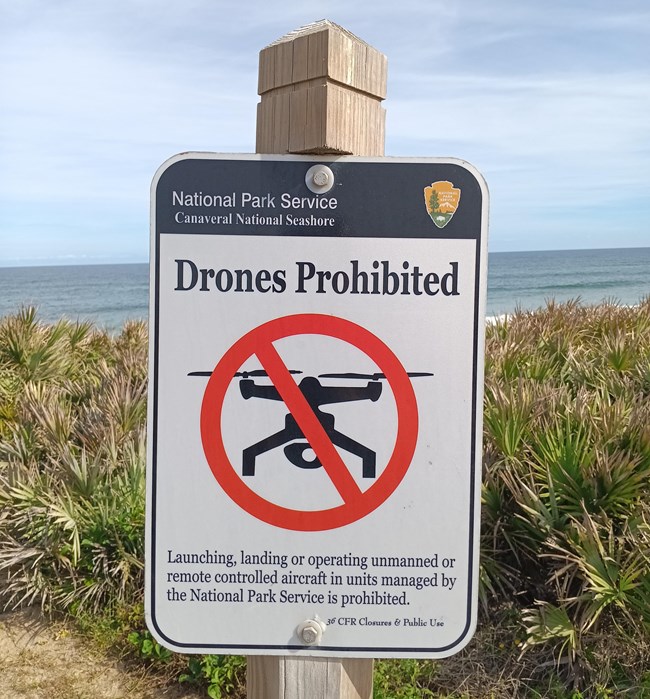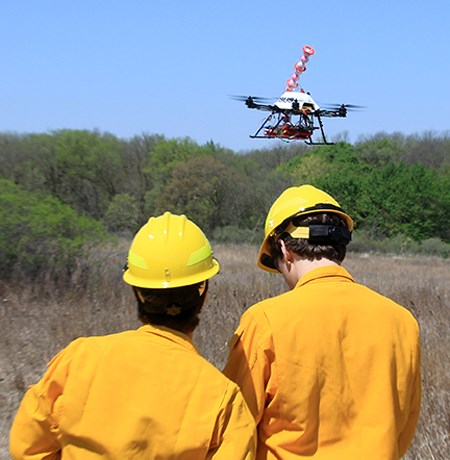
Photo: NPS/Natural Sounds and Night Skies Division
An "uncrewed aircraft" (or "unmanned aircraft") is a flying device that operates without a human pilot on board. This includes drones, model airplanes, quadcopters, and similar devices used for recreational, administrative, research, and commercial purposes. The term "uncrewed aircraft system" (UAS) encompasses the aircraft along with components such as cameras, sensors, and communication tools.
Public UAS Use
For the most part, launching or landing a UAS (including drone delivery) is prohibited in national parks.
The sight and sound of a UAS can be very disruptive to wildlife and to visitors, especially in national parks. Imagine stepping to the rim of the Grand Canyon only to hear the high whine of a drone engine or have a quadcopter photobomb your perfect shot. Or imagine being a bird or small mammal, and sensing a strange flying object—predator? rival?—swoop into your flightpath or over your head. Small objects flying at low altitudes can confuse and alarm animals, and the high-pitched sounds UASs make prove especially annoying to both people and wildlife. In some circumstances, unauthorized operation of a UAS could even interfere with emergency operations such as firefighting or search and rescue. For all of these reasons, depending on the park unit, unauthorized operation of a UAS may result in a fine, confiscation, and/or other repercussions.
Authorized UAS Use
On occasion, the NPS uses UAS for special administrative purposes, such as:
- Life Threatening (Emergency) and Operational (Urgent) Missions
- Wildland Fire and Search and Rescue Operations
- Structural assessments or scientific monitoring
- Procuring end products or services from contractors or vendors, such as aerial photography
External requests for UAS operations may also be permitted, though must follow specific requirements. Allowable external purposes include:
- UAS Operations for Scientific Research and Collecting Permits
- Agreements Incorporating UAS Missions
- Special Use Permits
Guidance on using UAS for administrative and research operations is outlined in the NPS Reference Manual 60, Aviation Management, Chapter 12: Uncrewed Aircraft Systems and Appendix 8: Permitting for Uncrewed Aircraft.

NPS / MIKE JOHNSON
Best Practices for UAS Operations
In collaboration with other NPS staff and an interagency group from the U.S. Geological Survey, Fish and Wildlife Service, Bureau of Land Management, U.S. Forest Service, and National Oceanic and Atmospheric Administration, the Natural Sounds and Night Skies Division has developed a set of best practices for avoiding impacts to natural, cultural, and historic resources when using UAS [Drop down menus below, or available as a PDF, 122 KB].
The best practices were developed to supplement the requirements in RM-60, Aviation Management. They are intended to assist personnel developing and approving requests for UAS operations to avoid impacts to natural, cultural, and historic resources. Superintendents may adopt more protective measures to address park-specific concerns. Note that in some cases, use of UAS itself may be the best practice, with respect to increased safety and a reduction in noise, compared to operation of crewed aircraft.
Because UAS technology and the state of knowledge are evolving rapidly, these best practices were developed to be flexible and may be updated as more information becomes available. They are consistent with Federal Aviation Administration, National Transportation Safety Board, Presidential Memoranda, the Department of Interior, and NPS requirements.
Pre-Flight Planning
Become familiar with the presence of the following resources in the mission area: noise-sensitive species, habitat, or nesting areas; cultural areas or events; archaeological and paleontological sites; and caves. Assess potential impacts of the mission on resources such as air, archaeological, biological, cultural, geological, hydrological, lightscapes, paleontological, soundscapes, viewsheds, and wilderness. Plan the mission to avoid direct and cumulative impacts by optimizing the route, speed, timing and frequency of flights, and employ technologies and operational parameters that help avoid impacts. Plan around seasonal and temporal considerations such as breeding and high times of visitor use.
Complete a Minimum Requirements Analysis (MRA) in accordance with NPS Management Policies 6.3.5 and 6.3.6 if UAS operations occur within or over designated wilderness or areas managed as wilderness and may impact wilderness character and values. This MRA is a documented, two-step process that determines:
- Whether the use is necessary for the administration of the area as wilderness and does not cause a significant impact to the wilderness character and values.
- The activity (method or tool) to accomplish the action (project) with the least negative impact to the wilderness character and values.
If the proposed use is deemed necessary under the first step of the analysis, UAS may only be used to accomplish that action if the analysis shows that the use of UAS, as compared to other alternatives, is the least impactful management method or tool to wilderness character and values. When making this determination, the potential disruption of wilderness character and values will be considered before, and given significantly more weight than, economic efficiency and convenience gained by using UAS.
Consider information about impacts to resources found in general management plans, foundation documents, natural resource condition assessments, and other planning documents. In addition to more traditional park resources, these resources may include an atmosphere of peace and tranquility, visual resources, and natural, historic, or commemorative locations within the park.
Consider impacts to resources that may occur from “lost link” situations or downed UAS, and utilize available technologies that allow the NPS to track and find UAS within the park to help avoid any such impacts.
Use the quietest UAS available that will accomplish the mission because noise from UAS can impact wildlife and other resources, especially when flown at low altitudes. Various models of UAS with different noise characteristics are available. For example, fixed-wing UAS tend to be quieter than rotary and tend to evoke less of a response in wildlife, and a canard configuration in a fixed-wing UAS is less likely to evoke an antipredator reaction than a conventional configuration.
During Mission
Operate UAS in a manner that minimizes audible and visual impacts to resources, including wildlife. If wildlife or other resources are encountered during the mission that may be affected by the UAS, modify the route, altitude, airspeed, or other operating parameters to minimize potential impacts, if possible without compromising the safety of the mission.
Note any valuable resource information gathered from the UAS mission in any post flight communications, including wildlife sightings, wildlife response, identification or condition of natural, cultural, or historical, resources, and any impacts to resources resulting from the UAS operation. Implement safeguards to ensure that locations of sensitive resource areas will not be made public in accordance with existing policies and laws. Sensitive areas may include archaeological sites, paleontological sites, caves, and sensitive wildlife habitat or nesting areas.
Last updated: April 30, 2025
